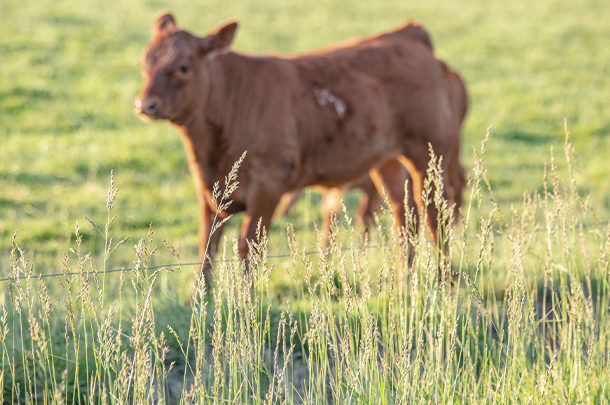Pasture improvement would be simplified if we just had a silver bullet to increase forage growth, improve nutritive value, control pasture weeds and graze longer throughout the year. Unfortunately, no one single management practice can do all of that, but when you start stacking management practices together, the improvements you will find in your pastures may astonish you.
Prong No. 1
The best way to improve your pastures is to start from the ground up. Soil sampling your pastures and applying lime and fertilizer as recommended is the foundation to any great pasture system. A point-step pasture analysis is another good tool to help you identify areas that need management attention. A point-step analysis can be done by walking in a zigzag pattern across your pasture. Every 10-20 steps, determine the plant species at the toe of your shoe and record them on your point-step worksheet (Table 1).
I usually tally the species under nine main columns of tall fescue, orchardgrass, bluegrass, white clover, other desirables, buttercup, other broadleaf weeds, grassy weeds and bare ground, but you can choose the column headings based off of species in your area.
After determining the species makeup of your pasture, take a step back and determine what the point-step analysis is telling you. A high frequency of Dutch white clover and bare ground could indicate overgrazing. Goosegrass and horsenettle could indicate compacted soils, and bitter sneezeweed could indicate low fertility. Thus, the next time you check cows, spend a little time looking down at what is growing under your feet; it could be the bit of information you need to improve your pastures.

Prong No. 2
An often overlooked topic in pasture management is plant physiology and morphology. Understanding plant growth aspects can help you determine how often and how short to graze, when to fertilize, tolerance to grazing, seasonal growth distribution and how persistent a forage species may be.
For example, forage species differ in where they store their energy reserves. Bahia, fescue, ryegrass and dallisgrass all store reserve energy at the stem base while white clover stores it in stolons and bermuda stores reserve energy in both stolons and rhizomes. This information tells us forages that store energy in stolons (on top of the ground) and/or rhizomes (underneath the ground) can withstand closer grazing than forages that store reserve energy in the bottom few inches of the stem base. This is why we often times see large patches of white clover in overgrazed pastures. The reserve storage organ in white clover lies so close to the ground that it rarely gets grazed, thus making it tolerant to close grazing pressure.
Prong No. 3
Finally, your path to pasture improvement would not be complete without the use of adaptive grazing management. Temporary fencing is a key management tool for adaptive grazing methods like rotational, strip, creep and many others. I have even seen producers use it for non-grazing purposes, such as to make alleyways for moving cattle, using it to load cattle onto a trailer and using it as a safety measure to prevent fence-line contact with a neighboring bull. Temporary fencing can be used to construct smaller paddocks within permanent border fences.
Some benefits of using smaller paddocks and rationing out forage is it makes animals less selective in their grazing habits, resulting in a more evenly grazed pasture. This practice also leads to a more even distribution of manure on the pasture, which plays an important role in nutrient recycling on the landscape. As a result of extended forage rest periods with adaptive grazing management, your pastures will produce more total forage and be more competitive with pasture weeds.
Temporary fencing can also be used to exclude cattle from heavy-use areas and create longer rest periods for forage. Over time, shade locations can become loaded with excess nutrients and muddy from repeated use. Adding a single strand of polywire fencing to exclude cattle from repeatedly going back to the same shade location can aid in recovery of pasture.
Pasture improvement does not happen overnight, nor is there a silver bullet. Improving your pasture will take time and planning. Discovering underlying issues and then developing a plan to incorporate several management practices together will help take your pasture systems to the next level.
Visit the Center for Environmental Farming Systems: Amazing Grazing for more information on pasture improvement and using temporary fencing.









